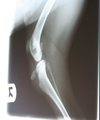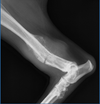Introduction to Fracture Repair (Betance 1) Flashcards
Complete or incomplete break in the continuity of bone or cartilage is defined as a_______
fracture
“The early return of the patient to full function of the limb” is defined as the ______ of fracture repair
goal
What are the methods of classification of fractures (6) Don’t Forget-Luers-RODS
Don’t Forget: DIRECTION of FRACTURE lines Lures: Location of the fracture on the bone R: Reducible or non O:Open or closed D: Displacement (of fracture segments) S: Specific (types of fractures)
State the direction of fracture lines: ?

Transverse
State the direction of fracture lines: ?

Oblique
State the direction of fracture lines: ?

Oblique
State the direction of fracture lines: ?

Spiral
State the direction of fracture lines: ?

Comminuted Reducible
State the direction of fracture lines: ?

Comminuted nonreducible
Label


Classify Harris classification


Classify Harris classification


This is an example of ______?

Reducibility
This is an example of ______?

Displacement
This is an example of ______?

Specific fractures: tibial tuberosity being distracted
This is an example of ______? Dog presented with acute onset of lameness

Specific fracture: from pathological fracture due to osteosarcoma
This is an example of ______?

Transverse fracture and fissure fracture
State the type of fracture (open or closed)
no communication with the external environment
Closed fracture
State the type of fracture:
at some point developed communication with the external environment

Open fracture
State the open fracture classification?
- Bone penetrating through skin
- Laceration < 1 cm
- Clean

Type 1
State the type of open fracture?
- External object penetrates soft tissue
- Laceration > 1 cm
- Mild soft tissue trauma

Type 2
State the open fracture classification
- Arterial supply damaged
- Requires arterial repair for limb salvage
Type 3c
State the open fracture classification
- Vast soft tissue laceration
- Soft tissue available for closure
Type 3a
State the type of open fracture?
- Extensive soft tissue injury and loss
- Bone exposure and stripped periosteum
Type 3b











